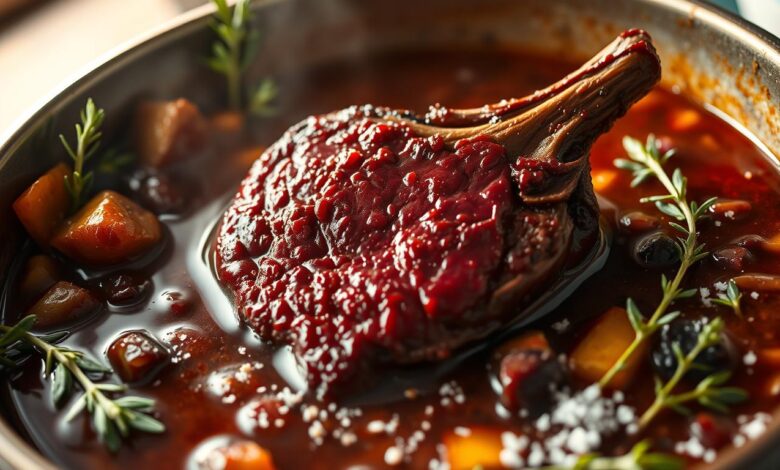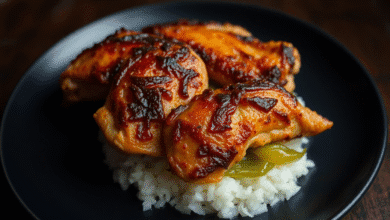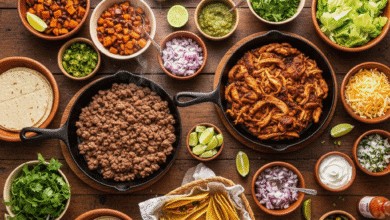How to Cook Beef Cheek Meat to Perfection

Ever wondered how to bring out the full flavor of beef cheek? This cut is rich in history and taste, making it exciting for both home cooks and chefs.

Exploring beef cheek, you’ll find its unique qualities and the joy it brings. It comes from cattle’s facial muscles, offering both flavor and tenderness when cooked right.
Mastering the art of cooking beef cheek can boost your cooking skills. It adds a new twist to your dishes. In this article, we’ll share tips and techniques to help you enjoy this exceptional ingredient.
Table of Contents
Understanding Beef Cheek Meat
Beef cheeks come from the facial muscles of cattle. They have a rich, unctuous texture and deep flavor when cooked slowly. Exploring beef cheeks reveals their unique traits and benefits.
What Are Beef Cheeks?
Beef cheeks are the muscles used for chewing by cattle. They are full of connective tissue. When cooked right, this tissue breaks down, making the meat tender and flavorful. This unique anatomy is what makes beef cheeks so special.
Nutritional Profile and Benefits
Beef cheeks are not just tasty but also nutritious. They are high in protein and full of iron, zinc, and B vitamins. They are a great choice for adding more nutrients to your diet.
Why Beef Cheeks Make Exceptional Dishes
The flavor and texture of beef cheeks are perfect for many dishes. Cooked slowly, they become incredibly tender. A culinary expert once said,
“The secret to a great dish lies in the quality of its ingredients and the patience with which it’s prepared.”
Beef cheeks live up to this saying, offering a memorable culinary experience.
Selecting and Preparing Beef Cheek Meat
The journey to a delicious beef cheek dish starts with the right selection and preparation. To make sure your beef cheek recipes are perfect, start with the best ingredients and techniques.
Choosing Quality Beef Cheeks
When buying beef cheeks, check their freshness and quality. Fresh cheeks should be a rich red color and firm. They should also be well-trimmed with a good fat-to-lean ratio.
Trimming and Cleaning
Cleaning and trimming the meat is key. Remove excess fat or connective tissue to improve texture. Use a sharp knife to trim carefully, keeping as much meat as you can.
Marinating and Seasoning Techniques
Marinating or seasoning beef cheeks boosts their flavor. Mix your favorite herbs and spices, or try a marinade with soy sauce, garlic, and thyme. Let it marinate for a few hours or overnight for the best taste.
Proper Storage Methods
If you’re not cooking the cheeks right away, store them properly. Keep them in an airtight container in the fridge for up to 3 days or freeze for longer. When freezing, wrap the meat tightly in plastic or foil to avoid freezer burn.

By following these steps, you’ll be on your way to making tasty beef cheek recipes that will wow your family and friends.
Essential Equipment for Cooking Beef Cheeks
Beef cheeks need special cooking gear to get their full flavor and tenderness. You’ll need a few key pieces for low and slow cooking or braising.
Slow Cookers and Pressure Cookers
Slow cookers are great for beef cheeks because they cook at low temperatures for a long time. This makes the meat tender and full of flavor. Pressure cookers, on the other hand, cook faster but still make the meat tender. They’re good for those who are in a hurry but want tasty beef cheeks.
- Slow cookers provide a hands-off approach to cooking beef cheeks.
- Pressure cookers reduce cooking time without sacrificing tenderness.
Dutch Ovens and Braising Pans
Dutch ovens and braising pans are great for both stovetop and oven cooking. They’re perfect for searing beef cheeks before slow cooking, adding a rich crust. These pans heat evenly, ensuring the beef cheeks cook well.
Look for heavy-bottomed construction and tight-fitting lids.
Thermometers and Other Helpful Tools
A meat thermometer is key to ensure beef cheeks are cooked safely. You’ll also need sharp knives, tongs, and a cutting board for prep.

With these essential tools, you’ll be ready to make delicious beef cheek dishes that will wow everyone.
Step-by-Step Cooking Techniques for Beef Cheek Meat
Cooking beef cheek meat needs patience and the right techniques. The method you choose affects the dish’s texture and taste.
Braising: The Classic Approach
Braising cooks beef cheeks in liquid over low heat for a long time. It’s perfect for beef cheeks because it makes the meat tender and flavorful.
Searing for Maximum Flavor
The first step is to sear the beef cheeks. This creates a rich, caramelized crust. Heat a skillet over high heat, add oil, and sear the cheeks until browned on all sides.
Creating the Perfect Braising Liquid
The braising liquid adds moisture and flavor. It’s made of stock, wine, and aromatics like onions and carrots. You can also add herbs and spices for extra flavor.
Temperature and Timing Guidelines
After searing and preparing the liquid, cover the dish. Then, put it in a preheated oven at 300°F (150°C). Braise the beef cheeks for 2-3 hours, until tender and easily shredded.
Slow Cooking for Ultimate Tenderness
Slow cooking makes beef cheeks tender. Cook in a slow cooker or crock pot for 8-10 hours. The low heat and moisture break down the connective tissues.
Pressure Cooking: Speed Without Sacrificing Quality
Pressure cooking is fast, cooking in under an hour. It’s great for those who want tender beef cheeks quickly without losing flavor.
Sous Vide Method for Precise Results
The sous vide method seals the beef cheeks in a vacuum bag. Then, cook in a water bath at a controlled temperature. It ensures consistent results and precise control over cooking.
Flavor Profiles and Seasoning for Beef Cheek Meat
Beef cheeks have a deep, beefy taste that’s perfect for many flavors. When cooking tender beef cheek, we aim to boost its taste without drowning it. We use herbs, spices, wines, and stocks to do this.
Classic Herb and Spice Combinations
Herbs and spices can make your beef cheek dishes richer and warmer. Thyme, rosemary, and bay leaves are great choices because they match the beef’s flavor. You can also try black pepper, paprika, and cloves for more depth.
Here’s a simple seasoning mix:
- 2 tablespoons of dried thyme
- 1 tablespoon of smoked paprika
- 1 teaspoon of ground black pepper
- 2 bay leaves
Wine and Stock Pairings
Wine and stock are key for braising and slow-cooking beef cheeks. Red wines like Cabernet Sauvignon and Merlot add a fruity taste. Stocks, whether beef or vegetable, add moisture and flavor.
| Wine/Stock | Flavor Profile | Best Pairing |
|---|---|---|
| Cabernet Sauvignon | Fruity, Tannic | Thyme, Rosemary |
| Beef Stock | Rich, Savory | Bay Leaves, Black Pepper |
International Flavor Inspirations
Beef cheeks can take on flavors from around the world. Korean BBQ-style uses soy sauce, garlic, and ginger. Mexican dishes might include cumin, chili powder, and lime juice.
“The versatility of beef cheeks allows for endless creativity in the kitchen.”
Balancing Rich and Acidic Elements
It’s important to balance rich and acidic flavors in your dish. The beef’s richness can be balanced by acidic ingredients like tomatoes, vinegar, or citrus. This balance makes the dish more enjoyable and prevents it from feeling too heavy.
By mastering these flavor and seasoning techniques, you can make tender beef cheek dishes that are both tasty and memorable.
Delicious Beef Cheek Recipes to Try
Beef cheeks are a versatile ingredient found in many tasty dishes around the world. They add rich flavors to European braises and bold spices to Asian dishes. This makes them perfect for a variety of mouth-watering meals.
Red Wine Braised Beef Cheeks
Red wine braised beef cheeks are incredibly tender and full of flavor. The secret to this dish is patience. The slow-cooked beef absorbs all the flavors from the red wine, stock, and herbs.
“Braising is a cooking technique that never fails to impress,” says a renowned chef.
“The way it tenderizes tougher cuts like beef cheeks, turning them into something truly sublime, is nothing short of culinary magic.”
Beef Cheek Tacos with Pickled Onions
Try beef cheek tacos with pickled onions for a modern twist. The beef is shredded and seasoned, then served in tacos with tangy pickled onion slaw. It’s a perfect mix of textures and flavors.
Hearty Beef Cheek Stew
A hearty beef cheek stew is a comforting choice. It’s made by slow-cooking beef cheeks with veggies and grains. This stew is perfect for cold weather.
Asian-Inspired Beef Cheek Dishes
Beef cheeks also shine in Asian-inspired dishes. They’re braised in soy sauce, ginger, and other aromatics. These dishes show how beef cheek meat can take on many flavors.
Exploring different recipes and flavors can help you enjoy the full potential of beef cheek meat. You’ll discover a variety of delicious meals to try.
Conclusion
Beef cheek meat is a treasure in the kitchen. It’s tender and full of flavor when cooked right. This makes it great for many dishes.
Now you know how to pick and prepare beef cheek meat. Try out different marinades and cooking methods. See what you like best.
Cooking beef cheeks is a skill that takes time to learn. But with practice, you’ll make dishes that wow everyone. So, start experimenting with beef cheek meat and enjoy the journey.
FAQ
What is beef cheek meat, and where does it come from?
Beef cheek meat, also known as beef cheeks, comes from a cow’s facial muscles. It’s prized for its rich flavor and tender texture when cooked right.
How do I choose the best beef cheeks for cooking?
Look for beef cheeks with a good mix of meat and fat. This mix enhances tenderness and flavor. Make sure they’re fresh and show no signs of spoilage.
What are the benefits of slow cooking beef cheeks?
Slow cooking breaks down tough tissues, making the meat tender and flavorful. It’s perfect for a melt-in-your-mouth texture.
Can I cook beef cheeks in a pressure cooker?
Yes, pressure cooking beef cheeks cuts down cooking time. It still makes the meat tender. It’s great for those in a hurry.
How do I store beef cheeks before cooking?
Store beef cheeks in the fridge at below 40°F (4°C). For longer storage, freeze them. Wrap them tightly to avoid freezer burn.
What are some common seasoning techniques for beef cheeks?
Common methods include marinating in herbs and spices, rubbing with spices, or using wine and stock for flavor.
Can I use beef cheeks in tacos?
Yes, beef cheeks are great in tacos. They become tender and easy to shred. Season and cook them as you like.
How do I achieve a tender beef cheek stew?
Cook beef cheeks low and slow in a slow cooker or Dutch oven. This breaks down tissues, making the meat tender.
Are there any specific thermometers recommended for cooking beef cheeks?
A meat thermometer is key for safe cooking. Choose one that stays in the meat during cooking for continuous monitoring.
Can I cook beef cheeks using the sous vide method?
Yes, sous vide is great for beef cheeks. It offers precise temperature control for the perfect tenderness.
SOURCES:
Crab Brûlée Recipe: Elevate Your Cooking with This Dish




